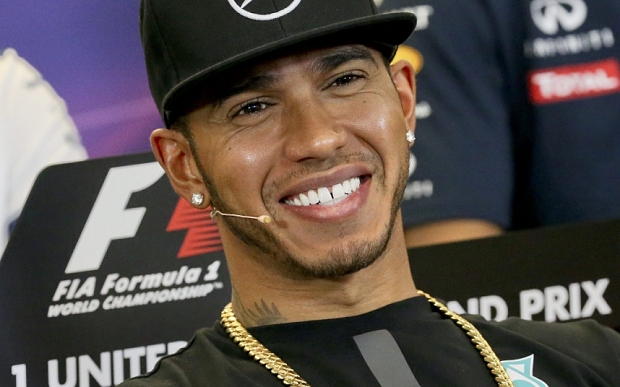



Lewis Hamilton
IN the wake of Sebastian Vettel’s victory in the Bahrain Grand Prix, Mercedes are facing a decision they hoped they would never have to make.
The manner of Vettel’s win, the second in three races so far this season for the Ferrari man, could force them into picking a number one driver, and asking the other to play back-up to his title bid.
That is what eventually happened in Bahrain, when Mercedes finally – just before half-distance – grasped the nettle and ordered Valtteri Bottas to move over and let Lewis Hamilton by.
By then, it was too little too late. Vettel had a six-second lead and, despite a valiant charge by Hamilton after a late pit stop, the German won by about the same margin.
Afterwards, the mood at Mercedes matched the night skies on the Arabian peninsula, and team boss Toto Wolff was already grappling with his conundrum.
How long before you have to choose one driver to back for the title, he was asked?
“We don’t like that,” he said. “At all. It is not what we have done the past couple of years. But the situation is different now. So it needs a proper analysis what it means and where we are.
“We’d like to give each of them equal opportunity at the start of the race. We owe it to them. Then you see what we did in the race. We made the call. We made the call twice.”

Just as in Australia at the first race of the season, Vettel and Ferrari’s victory was based on aggressive strategic thinking and good use of tyres.
The German, third on the grid, jumped Hamilton off the line – as he was always likely to do from the cleaner side of the grid – and slotted into second place behind Bottas.
The Finn had taken his first pole position on Saturday. He overhauled Hamilton after what Mercedes said was a rear-end snap in Turn 10 on Hamilton’s final lap, but which Hamilton said after the race was largely because the DRS overtaking aid, which boosts straight-line speed, did not engage between Turns 10 and 11.
Bottas lacked pace in the race. Mercedes said that in the first stint he was hamstrung by high tyre pressures caused by a generator failure on the grid which prevented the team from bleeding out enough air. The result was a five-car queue, comprising Vettel, Hamilton and the two Red Bulls.
With Vettel stuck, but sensing he had a very quick race car, Ferrari took the initiative, pitting him early on lap 10. There was no point Mercedes following him in – they knew whoever they pitted would come out behind.

A safety car three laps later gave Vettel what he said was “a heart stop” that he might lose a potential advantage gained in this way for the second week in succession, just as he had in China.
But a slow stop for Bottas, caused by problems with pit equipment, ensured Vettel retained the lead – and Hamilton delivered his own race another blow by driving too slowly on the way into the pits, trying to give the team time to service Bottas and also prevent Daniel Ricciardo from jumping him. It earned him a five-second penalty. Without it, the end of the race would have been much closer.
With Vettel now in the lead, and Hamilton stuck behind Bottas, who was still slow despite corrected tyre pressures, the Ferrari began to edge ahead – 1.2secs at the restart, then 1.6, 2.1, 2.3, 2.7, 2.9, 3.5, 4.1, 4.9 etc. Only when Vettel had an advantage of more than six seconds did Mercedes finally make the call for the drivers to swap positions.
Immediately, Hamilton came back at Vettel, closing to within 4.3secs within five laps before the Ferrari made its second and final pit stop. Mercedes’ only hope was to leave Hamilton as late as possible before his final stop. But 19 seconds in 15 laps was always going to be too big a margin to close down.

Wolff said he didn’t think Mercedes lacked race pace, but there was a suspicion within the team that Ferrari had the edge in Bahrain.
Even so, they might have been able to fend them off without all the various things that went wrong, whether it be failed equipment or questionable decisions Mercedes will analyse in the coming days.
Arguing over what might have been is one thing, but there is a more fundamental point at play – which is the margins are too tight this season for mistakes to be made.
Over the previous three years, Mercedes have been dominant enough to be able to allow their drivers to fight with minimal interference. Only in very rare cases – such as when Nico Rosberg’s lack of pace in the wet was harming the team’s chances of victory with Hamilton in Monaco last year – have they asked one driver to give way.
This year, it already looks as if they do not have that luxury. And while Wolff is not yet saying they will have to bite the bullet and back one driver – which surely will be Hamilton, given his seniority, greater experience and better start to the season – he is at least accepting it needs to be thought about.
Mercedes did not act sooner in Bahrain, Wolff said, because it was relatively early in a race so early in the season and was “a tough call”. But he was, he added, going away to think about it.
“I don’t want to pre-empt what the consequence will be or if there will be a consequence and what it will mean for the championship,” Wolff said. “It is a question Ferrari needs to ask themselves as well.”

McLaren had a double PR coup in the week running up to the race, with the announcement on Wednesday that Fernando Alonso would race in the Indianapolis 500, followed by confirmation Jenson Button would replace him at the Monaco Grand Prix.
It did not take long for reality to burst back front of frame, though.
After a dismal pre-season testing programme, engine partner Honda largely kept reliability under control in the first two races, albeit at the expense of performance, even if Alonso could finish neither despite strong drives into points positions.
But the inherent fragility of an engine that is said to be about 120bhp off the best was exposed in the heat of Bahrain, with Honda suffering through practice and qualifying no less than three failures of the MGU-H – the part of the hybrid system that recovers energy from the turbo.
Two of these afflicted Stoffel Vandoorne; one Alonso. But while Vandoorne’s were in practice, Alonso’s exploded on his first flying lap in second qualifying.
Unsurprisingly, McLaren’s Saturday evening news conference was a depressing place to be.
An unusually short six minutes of awkward questions and answers elicited little information other than that Honda does not know the cause of the MGU-H failures, although F1 boss Yusuke Hasegawa said it was “possibly” related to the circuit and conditions.
All three MGU-Hs are destroyed – and each driver has only four for the season before taking a grid penalty. It took a bit of digging afterwards to discover the failure on Alonso’s car also trashed his internal combustion engine. Vandoorne suffered another MGU-H failure – the fourth of the weekend – before the race and could not start.
Back in the McLaren news conference on Saturday, someone asked Alonso whether the driveability of the Honda engine was at least any good. It produced a withering response: “I don’t care too much about the driveability if I can’t finish a race or a lap in qualifying now.”
The news conference was brought to an end shortly after that.

Straight afterwards, Hasegawa went to see Alonso. It was a mistake. Alonso directed him into an office and, still visible through the darkened windows, proceeded to have a largely one-sided, animated conversation.
The Spaniard was very obviously making his feelings clear, albeit in a more controlled fashion than might have been expected in the circumstances.
“I see you had a bit of a chat with Hasegawa-san,” I said to him afterwards. “Yes,” Alonso replied. “Always calm. You know me.”
Calm he may be on the outside, but the frustration of driving an uncompetitive car for the third consecutive season is burning inside.
It boiled over in the race, in which he battled for all he was worth for 11th place with Jolyon Palmer’s Renault and Daniil Kvyat’s Toro Rosso.
Alonso said over the radio he had “never raced an engine with less power” – clearly a message for Honda. After observing that Esteban Ocon’s Force India had made up 300 metres on him on one straight, he was asked by engineer Mark Temple for his thoughts on a change of strategy. His reply? “Do what you want, man.”
This was not Alonso saying he didn’t care. Quite the opposite. He cares very much. As everyone knows, his rightful place is battling at the front. This unsatisfied rage to win is at least partly behind his decision to race at Indy.
Alonso’s McLaren contract runs out at the end of this season and racing director Eric Boullier effectively admitted in Bahrain that the Indy programme – and perhaps a future shot at Le Mans – is an attempt to make staying more attractive.
As for Alonso, he said that, much as he wants to win the so-called ‘triple crown’, further success in F1 is his main priority. He wants a competitive car next year.
How he will get one is unclear. The chances of him going to Mercedes, Ferrari or Red Bull are minimal, which leaves a choice of either staying at McLaren or moving to the fast-improving Renault team.
McLaren have explored the idea of switching to Mercedes customer engines, as BBC Sport revealed last month, but senior sources say the prospect of that happening have now evaporated.
McLaren’s official position has always been they are committed to Honda; Honda’s is it is “100% committed to our future in Formula 1”.
New parts will be tried at this week’s test in Bahrain. An engine with an upgrade – albeit a small one – is due at the Spanish Grand Prix next month.
But if they are going to convince Alonso to stay, Honda needs to find more than small improvements. And it needs to find them fast. – bbc.com